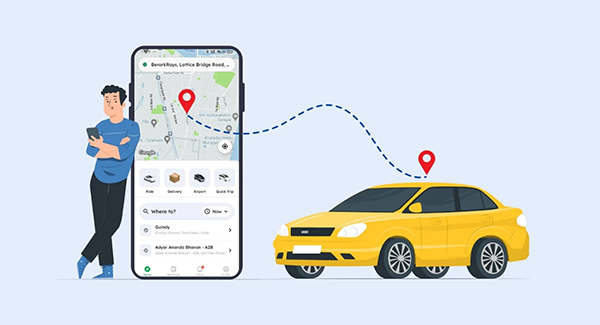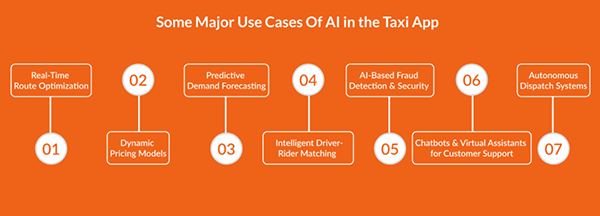AI-driven Decision Making for Taxi and Ride-hailing Businesses

In the transport service industry, the evolution from reliance on human intuition and traditional pen-and-paper planning to advanced technological solutions marks a significant transformation. Artificial intelligence has emerged as a pivotal tool, transcending mere buzzwords associated with tech giants.
This offers practical applications that help improve daily operations, particularly in areas such as taxi management, dispatching, and fleet oversight. In fact, the market for AI-powered taxi apps is projected to reach 13.43 billion USD by the end of 2025.
To clarify the concept, we need to check out the basic principles of AI-driven decision-making, its relevance to your business, and the tangible solutions it provides to the challenges encountered almost every day.
Let’s start exploring more extensively in this article, right below!
KEY TAKEAWAYS
- In today’s competitive landscape, leveraging AI for decision-making is crucial to meet soaring customer expectations and avoid costly mistakes, giving you more control over your operations
- AI may sound a little complex. It acts as an ever-vigilant partner, enhancing your decision-making and life quality.
- AI transforms everyday taxi operations with smarter assignments, demand prediction, route optimization, dynamic pricing, and fleet load balancing.
- Reduced operating expenses, improved use of resources, increased customer satisfaction, and driver satisfaction are some benefits of AI in the taxi industry.
- Embrace user-friendly AI solutions tailored for taxi operations, no tech expertise needed.
- Just start with small routes, decide the right partner, and continuously track improvements.
Why Smarter Decisions Matter More Than Ever
The reason taking smart AI-driven decisions is so important now more than ever is simple: customer expectations are at an unprecedented high.
One wrong movement and all goes to ineffectiveness. What we are intending to say is: one bad experience can do tremendous damage to your business.
Modern travelers demand polite drivers, fast rides, and inexpensive fares. At the same time, traffic gets worse, fuel prices keep rising, and competition becomes stronger by the day.
Now, imagine trying to cope with all this using just your subconscious feelings. It is hard and can typically lead to misunderstandings, which is the last thing you want.
Let’s say you, in some manner, managed to offer accurate service without making any mistakes. Do you think it takes away all your issues? Of course, no.
Here are some common mistakes made during manual operations:
- Vehicles go idle
- Drivers get frustrated
- Customers wait too long
- Trips get missed
It all ultimately adds up to lost revenue and unhappy clients.
This is where AI steps in.
Not to replace people, but to encourage them to make smarter decisions with real-time observations and predictions. It will give you more control over your operations.
AI in Simple Words: What it Really Means for Your Business
AI may sound a little complex. But in your world, it generally means using software that can:
- Gain knowledge from historical data, such as demand trends, driver behavior, and your trip history.
- Spot trends and styles humans might miss.
- Suggest or make thoughtful decisions in real-time.
Think of it like a co-pilot for your business. Quietly providing support behind the scenes, 24/7.
It doesn’t need breaks, get tired, or require you to make emotional choices, and it doesn’t end here. By assisting you in making data-driven decisions, it further improves your quality of life.
Where AI Helps in Real, Everyday Taxi Operations
Let’s discuss details. What can AI really do for you?

1. Smarter trip assignments
AI is able to analyze real-time data, including location, traffic, and driver availability. The closest and most qualified driver is then assigned for a reservation based on that. This reduces standby time for customers and cuts down rest time for drivers.
2. Predicting demand before it happens
AI can gain insight from historical ride data, like how passenger traffic spikes near malls on weekends or drops during rain. In order to help you prepare, it can use this to notify you beforehand. Drivers can be assigned to areas where demand is anticipated rather than where you hope it will be.
3. Route optimization
Due to poor route choice, drivers often lose time and fuel. AI can find the fastest and most cost-effective route by analyzing road closures, traffic, and congestion in real time. This lowers expenses and enables drivers to finish more rides in a day.
4. Dynamic pricing
AI can automatically adjust fares during peak periods, holidays, and late-night hours. This assists you in earning more without manual effort. Because the pricing is based on real-time demand, it stays transparent and competitive.
5. Load balancing across the fleet
While specific drivers get more trips, others sit idle. AI addresses this by distributing jobs fairly among available drivers, increasing their satisfaction and performance.
Even though each of these choices may seem insignificant, taken as a whole, they significantly affect your productivity, client satisfaction, and financial results.
Benefits Businesses Can Actually Gain from AI-driven Decision Making
Here’s what AI-based decision-making contributes to your taxi or ride-hailing business:
- Lower operational costs: You waste less time, fuel, and manpower.
- Better resource utilization: Every driver and motor vehicle is put to good use.
- Higher customer satisfaction: Rides arrive on time. Wait times drop. Service improves.
- Scalability: AI helps you grow without doubling your staff or stress.
- Driver happiness: Fairer trip scheduling and reduced idle time lead to more income.
Real advancements that you can sense every day are more important than gaudy dashboards.
INTERESTING FACT
Gottlieb Daimler created the Daimler Victoria, the first motorized taximeter-cab in history, in 1897.
“But We’re Not a Tech Company.” – Will this Still Work for Us
That’s okay if you’re thinking, “This sounds fantastic, but I’m not into tech.”
Most contemporary AI solutions are made for company owners like you. Building your own tools or employing a group of data scientists are not necessary.
All you have to do is use a platform that is designed specifically for taxi operations and handles all of the important and time-consuming tasks for you.
AI today is,
- simple to use
- fits into your existing workflow
- keeps running your fleet
- gets you better results
It’s already being used by small and medium-sized taxi businesses.
How to Get Started with AI (Without Getting Overwhelmed)
If you’re currently thinking of exploring AI for your business, here’s a very basic plan:
- Start small. Choose one area, like smart dispatching or route optimization, and test it.
- Decide the right partner. Look for an AI-based dispatch platform that understands taxi and shuttle service operations, not just general tech.
- Track improvements. See how AI-driven decision-making can change your operations week by week.
AI only needs the correct tools and an open mind; it doesn’t require a significant shift.
Conclusion
Mindful decisions make or break your success; hence, evaluating data becomes crucial. At the moment when every minute counts, AI helps you make those decisions smarter, faster, and more profitably.
Because AI isn’t just for tomorrow—it’s already assisting taxi businesses today—you don’t need to be a tech expert; all you require is an open mind.
Let your next ride, next route, next dispatch, and next strategy be backed by intelligence that never truly sleeps. That’s what AI-driven decision-making offers.
You need to use AI sooner rather than later if you want to stay ahead of the competition.
Ans: To improve dispatching in taxi AI uses real-time data like driver availability, passenger demand, and traffic conditions to automatically match passengers with the nearest available driver.
Ans: AI-powered route optimization uses real-time traffic data and travel patterns to find the fastest and most efficient routes for drivers, reducing travel time, fuel consumption, and ultimately improving the overall service.
Ans: It can personalize user experience by offering desired recommendations, predicting user preferences, and providing efficient customer support through chatbots.
Ans: Yes, AI can predict maintenance needs, automate dispatch, and minimize fuel consumption to reduce overall operational costs.
